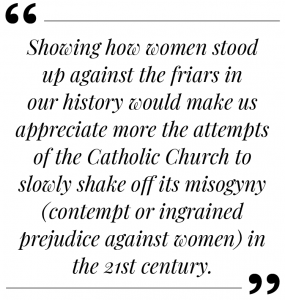 I only got to watch the movie “GomBurZa” last January 9 and it is the only movie from the Metro Manila Film Festival (MMFF) that I have seen so far.
I only got to watch the movie “GomBurZa” last January 9 and it is the only movie from the Metro Manila Film Festival (MMFF) that I have seen so far.
Watching Filipino movies in an actual movie theater has been a favorite bonding ritual of mine with my friends, Carol Arguillas and the late Pidot Villocino. It’s not even about the movie we watch but the side commentary while watching it together that makes the entire experience special. Pidot’s booming voice – that can only be described as sounding like someone who swallowed a microphone – made it even more special because the whole movie theater got to hear his colorful commentaries and react to them, too. It’s a truly communal experience. Ah, how we miss you, dear Pidot!
Carol and I watched “GomBurZa” with our friend, Amy Bandiola-Cabusao, who was a few minutes late because of the horrible Davao traffic (yes, I had to put that in there). Carol was watching the movie for the second time and she did not mind watching it again because she wanted to experience it with Amy and me, the president and vice-president, respectively, of the Davao Historical Society (DHS).
I guess if Amy and I had to watch just one MMFF movie, it should be the historical one, right?
So I must admit that I had expected to be impressed. For one, it’s produced by Jesuit Communications and I am a product of Jesuit education so it’s kind of ingrained in me to believe that anything from the Jesuits would be automatically better than the usual.
Maybe that bias got in the way of my enjoyment of the movie. I kept waiting for that pivotal moment that would move me to feel something stronger than Piolo Pascual speaking in Spanish to jolt me; something that would resonate inside me and awaken the Filipino in me; something new that would lead to an a-ha moment. Sadly, it did not come.
I do not know if the use of multiple languages made it more difficult for me to feel connected to the story. Shifting from Tagalog to Spanish to Latin and reading subtitles in English are probably too much work for my already exhausted brain that just wanted to relax and see a movie.
Also the movie is very dark it strained my already tired eyes. Well, it’s probably because there’s no electricity yet during the Spanish times so it’s just all candle-lit and literally dark in the Philippines. Metaphorically dark, too, because oppression and injustice and all that.
But what really bothered me about the movie “GomBurZa” is — where are the women?
It had one opportunity to tell a story about one woman, Teodora Alonzo, the mother of Jose Rizal. Why did they include that scene of Rizal witnessing his mother being arrested by Spanish authorities without providing context? I don’t think adding a little of Teodora’s story will dilute the focus from the three priests. In fact, it would enhance the story of injustice.
Like GomBurZa, Teodora was a victim of injustice and fake news. Even though she belonged to the principalia class, the Filipino nobility during the Spanish time who came from the line of former datus, who enjoyed certain privileges like holding public office, tax exemptions, and leasing vast tracts of land, she still suffered persecution.
According to historical accounts, Teodora lived on land owned by the friars, the Calamba estate. She always came in conflict with the friars and was subjected to all kinds of vexations and false charges.
That scene showed in the movie “GomBurZa” was probably the one in 1870s when Rizal was only 11 years old and Teodora was 45. Rizal’s mother was held without trial for two and half years. She was falsely accused of trying to poison her sister-in-law.
Telling Teodora’s tale as a side story to the martyrdom of the three priests that inspired Rizal’s “El Filibusterismo” would have had more impact. It would have been a richer and fuller story of the Filipino struggle for equality.
I believe it is important in movies about our Philippine history made today that filmmakers and historians make a conscious effort to include women’s stories. If we must tell our story as a people, let us not leave out half of the population.
The story of our oppression as a people is not complete without highlighting the oppression of our women by the Spanish colonizers, including the Catholic Church.
Filipino women enjoyed an elevated status prior to Spanish colonization. In pre-colonial communities, men and women tended to be viewed as equals. That equality is even reflected in their version of the account of creation. Both Malakas (man) and Maganda (woman) were created at the same time – coming out together from one bamboo split into two. There is mutuality, not subordination.
With the coming of Catholicism during the Spanish colonization, women became inferior and subordinated. The story of creation became Adam followed by Eve. Woman was made after man so he won’t be alone. A mere afterthought. Later on, it was also woman who caused man’s fall, because Eve succumbed to temptation. Woman became the source of original sin. Her punishment is the pain of childbirth with the man as her master.
The Latin word “Femina,” from where the word female comes from, literally means “less in faith.” So, clearly, even in church, that was supposed to be a sanctuary and refuge, women were treated as inferior.
Of course, we know now, thanks to the work of feminist historians, that women played key roles in the struggle for justice, equality, and liberation throughout Philippine history. They just did not cry or cook or serve food as depicted in the movie “GomBurZa.” Actually, come to think of it, I have not heard a woman speak in the entire movie.
Showing how women stood up against the friars in our history would make us appreciate more the attempts of the Catholic Church to slowly shake off its misogyny (contempt or ingrained prejudice against women) in the 21st century.
That is why I am disappointed that the movie “GomBurZa,” showing in the year 2023, missed an historic opportunity to make women visible in Philippine history. Why did they include that bit on Teodora Alonzo and just wasted it?
Now I get why it did not win best picture and why it is not a box-office hit. ###




